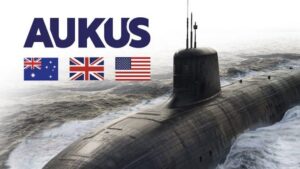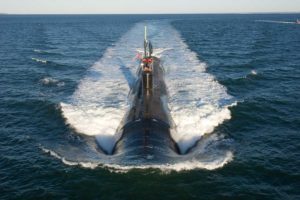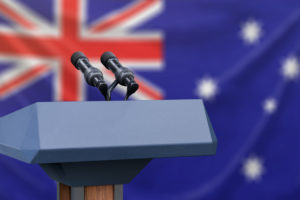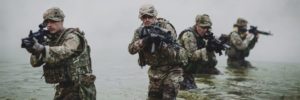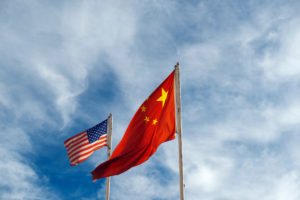September 2023
Australia, the United Kingdom, and the United States recently entered into a defense partnership that could effectively challenge China’s efforts to dominate the Indo-Pacific region. Known as AUKUS, this initiative brings together three historic partners to provide Australia with conventionally armed nuclear submarines and make a clear commitment to the development and sharing of advanced capabilities. A shared commitment to a substantive defense program like nuclear-powered attack submarines is a logical place to start since it is a tangible demonstration of trust to share such a technologically advanced program. However, it suggests that this long-term partnership could also thrive through less public but equally enduring opportunities. Beyond the advanced capabilities cited in the agreement, this could allow for better intelligence sharing across the three countries and more closely integrated strategies across the various defense establishments. In all cases, stronger personal ties would deepen linkages across the partnership. For militaries, there is no easier way to deliberately improve personal ties than the professional military education (PME) system, and AUKUS offers a unique opportunity to use PME to create a core cadre of military officers (and potentially civil servants) that could strengthen the trilateral partnership even more.
Why cooperation through PME? Compared to other means of cooperation, PME has a relatively low barrier to entry. Direct and indirect costs revolve around student moves and school tuition, as well as ensuring duties are covered while officers are attending school. Moreover, the time from design to implementation can be measured in months rather than the years associated with building a nuclear submarine. PME thus offers a way to create an AUKUS cadre that could be working together years before Australia commissions its first nuclear submarine.
To be clear, though, an AUKUS PME program would need to differ significantly from current programs involving international students. Putting aside deeper issues associated with institutional PME, existing PME institutions create curricula that compel exchange students to serve as de facto country ambassadors even while participating in an academic program. To build tripartite trust, the AUKUS students must meet on equal terms without additional, albeit informal, responsibilities disrupting that balance. A trilateral, year-long graduate seminar loosely based on the Secretary of Defense’s Strategic Thinkers Program (STP) at Johns Hopkins University School for Advanced International Studies offers a potential departure point (full disclosure, I teach in this program).
Some potential program components. Small, intense, Oxford-based tutorial seminars underpin STP. Any AUKUS graduate program could similarly place the student seminar at its core. To ensure success, the initial seminar might consist of no more than nine or 10 students, with each nation offering up a diverse group of students from their key military components. Most importantly, neither a nation nor a service should dominate the seminar’s composition. In terms of content, the seminar would only succeed with a strong, well-developed syllabus. Certainly, considerable thought would need to go into its design and its relationship to possible electives, but the syllabus might include these four major components:
- Comparative analyses focused on the development of the three militaries. This would include potentially contentious issues such as inter-service competition for roles and missions, organizational learning and adaptation, and civil-military relationships.
- Contemporary issues impacting the three militaries, to include, perhaps, recruiting challenges, dispersed operations, and implementation of national strategies. In addition, this could present an opportunity for creative thinking about how the three militaries could work together more effectively to address major strategic and operational problems.
- Historical wartime case studies of previous partnership efforts, with a focus on less successful attempts at partnering as well as the more heralded successes. These case studies would span the 20th and early 21st For example, one seminar block of lessons might focus on World War II, including the creation of the American-British-Dutch-Australian command; coalition operations in the China-Burma-India theater; the Combined Bomber Offensive; and Operation Oboe, the Australian-led amphibious assaults in North Borneo.
- A comprehensive study of Indo-Pacific geography, to include its human, regional, physical, and military Given the vast expanse covered by the Indo-Pacific, the latter might be of particular importance. Servicemembers’ principal operating domain—whether land, sea, air, space, or the information realm—usually shapes their assumptions of how a conflict might unfold, and the Indo-Pacific offers myriad challenges in every domain. Building a shared understanding of these different geographic dimensions and their associated operational demands would enhance understanding across AUKUS.
Two experiential learning aspects could round out an AUKUS PME program. The first would include crisis simulations and wargames to allow the students to wrestle with strategic and operational challenges as a team. A second and critical aspect of an AUKUS program would consist of extensive travel. The travel could include in-depth military staff rides or political-economic-social immersions that would allow students to experience in person what they had studied and debated in seminars and simulations. These are not pleasure trips; each trip would need considerable planning and rigor to meet a specific syllabus objective, demanding student preparation, and sufficient length for the students to absorb the “conditions on the ground.”
Institutional considerations. Assuming such a program has merit, creating it would require institutional agility from the three defense establishments. First, they would need to agree on the type and location of the institution. Concerning the former, the options range widely from a single military institution such as a war college to a military-university conglomerate comprised of some AUKUS war colleges to a military-civilian partnership based on the STP model or even a civilian-university conglomerate that spans the AUKUS alliance, perhaps akin to the PLuS Alliance. The institutional structure would help determine the location for any such AUKUS program. For example, if AUKUS partners determine that regional proximity is critical, this would make Australia the obvious choice, but other factors could make the United Kingdom or United States equally appealing locations. One could even argue for moving the student cohort among the three countries, but that, plus regional travel demands, could well prove exhausting for the students and program director.
The selection of the right program director is perhaps the most important factor in creating a successful AUKUS PME program. This individual must possess great credibility within both higher education and military circles. The military leadership should have sufficient confidence in this individual to minimize the need for close oversight and multiple reporting requirements. Mid-year and end-of-term evaluations, individual conversations with students, and periodic alumni assessments should suffice to assess the program’s success. With three partners to keep apprised of the program, such an undertaking is daunting. In fact, if an AUKUS PME program does materialize, appointing one of the members as the primary partner for oversight could make sense.
Indeed, willingness to cover a larger portion of the program’s costs could be a potential criterion for determining oversight responsibilities. Ideally, for such a small program, the three partners would share the costs equally, but circumstances might dictate differently. While each nation should absorb the military personnel costs for sponsoring its student cohort, the institutional costs of hosting such a program—paying for physical spaces, student services, additional faculty, etc.—could tilt the costs to one partner over the others. In any event, for an AUKUS PME initiative to succeed, the partners would need realistic means to assess this program on behalf of their defense organizations without placing unrealistic demands, whether bureaucratic or financial, on the director.
Adding an 18th AUKUS trilateral working group for Professional Military (& Civilian) Defense Education perhaps offers the best way to explore the potential for military education cooperation. Such a working group would ensure that the three countries understood each other’s specific officer educational development needs while simultaneously working to strengthen the AUKUS partnership. They could explore these various requirements as a group and involve operators, educators, and defense officials as necessary to better understand what a trilateral program might look like. Regardless of its final structure, for an AUKUS program to succeed, it must significantly improve an individual officer’s education and critical thinking skills and result in strengthening the ties that bind this historic partnership.
Developing the AUKUS cadre beyond the classroom. Finally, if the three AUKUS defense establishments agree on the wisdom of creating a unique PME program, they need to recognize that the program could fail to achieve its objectives if it doesn’t provide the proper talent management for its graduates. Ideally, for an AUKUS PME program to succeed, each partner would identify positions at the field grade and even flag officer ranks that would benefit from AUKUS PME graduates. Partners could also consider routine, inexpensive ways to periodically re-immerse AUKUS graduates in partnership dynamics and issues. Such initiatives would ensure the building of expertise and trust beyond the seminar.
Without the partners paying close attention to the talent management of their graduates, military personnel systems could place these graduates in assignments around the globe with little or no ties to the Indo-Pacific or AUKUS. Moreover, individual service requirements for command at various levels could mean graduates never directly apply what they learn as they move from one level of command to the next. In short, the AUKUS members should not establish a first-rate graduate education program if they are unwilling to invest in the proper placement and development of its graduates.
AUKUS offers a unique opportunity for PME innovation. The price of entry is relatively low and the number of individuals involved is small. Innovation in this area would directly impact only a handful of officers drawn from Australia, the United Kingdom, and the United States. However, with strong support from the three defense establishments, as well as the right program director, this PME initiative could, within a couple of years, create an AUKUS field-grade officer cohort with an impact well beyond its early, smallish size. This cohort, as it grows and its members move up their respective officer ranks, would possess a deep understanding of the AUKUS partners and the Indo-Pacific region and its key players. Most importantly, it would engender a deep trust that would encourage sharing strategies, intelligence, and operational plans under all circumstances. When thinking about any AUKUS PME program’s costs versus its return on investment, such trust and its attendant benefits are, simply, priceless.
